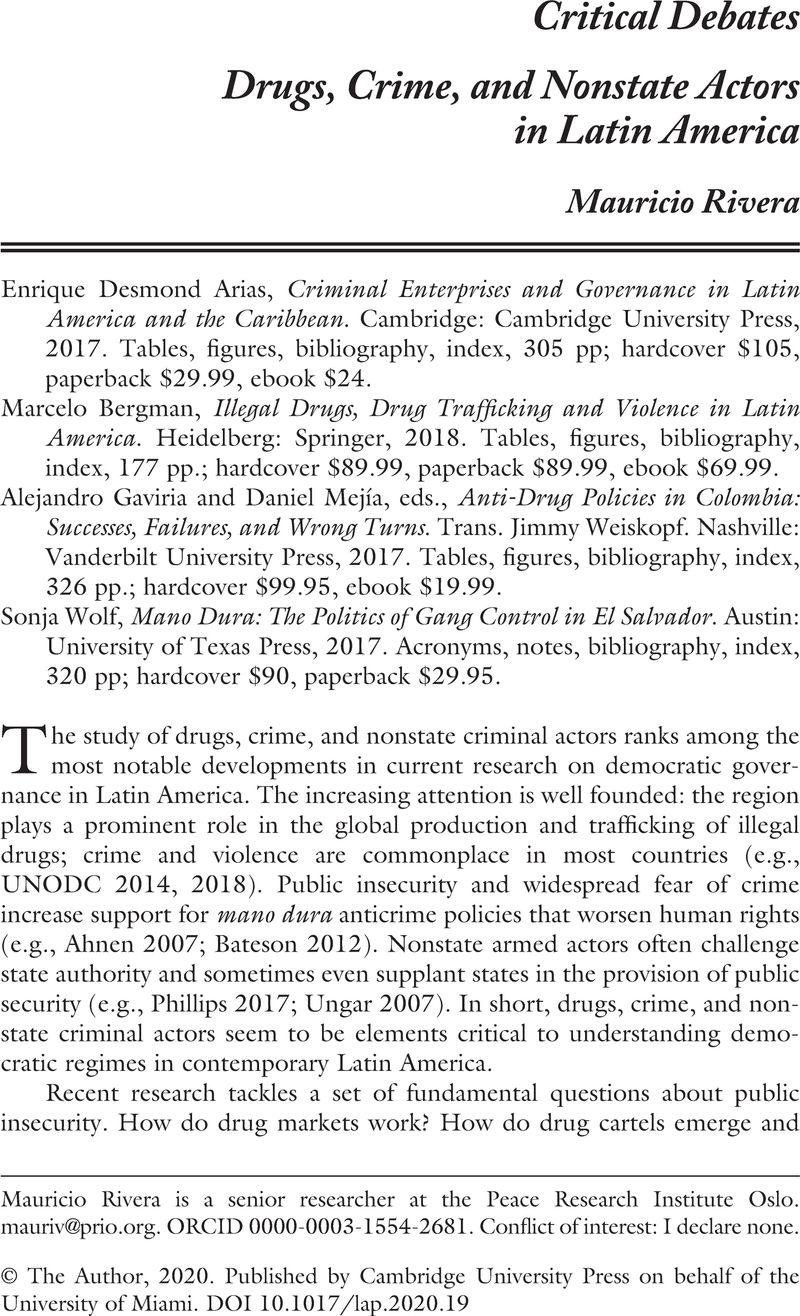No CrossRef data available.
Article contents
Drugs, Crime, and Nonstate Actors in Latin America
Review products
Enrique DesmondArias, Criminal Enterprises and Governance in Latin America and the Caribbean. Cambridge: Cambridge University Press, 2017. Tables, figures, bibliography, index, 305 pp; hardcover $105, paperback $29.99, ebook $24.
MarceloBergman, Illegal Drugs, Drug Trafficking and Violence in Latin America. Heidelberg: Springer, 2018. Tables, figures, bibliography, index, 177 pp.; hardcover $89.99, paperback $89.99, ebook $69.99.
AlejandroGaviria and DanielMejía, eds., Anti-Drug Policies in Colombia: Successes, Failures, and Wrong Turns. Trans. Jimmy Weiskopf. Nashville: Vanderbilt University Press, 2017. Tables, figures, bibliography, index, 326 pp.; hardcover $99.95, ebook $19.99.
Published online by Cambridge University Press: 12 October 2020
Abstract
An abstract is not available for this content so a preview has been provided. Please use the Get access link above for information on how to access this content.

- Type
- Critical Debates
- Information
- Copyright
- © The Author, 2020. Published by Cambridge University Press on behalf of the University of Miami
Footnotes
Conflict of interest: I declare none.
References
Ahnen, Ronald. 2007. The Politics of Police Violence in Democratic Brazil. Latin American Politics and Society 49, 1: 141–64.CrossRefGoogle Scholar
Bateson, Regina. 2012. Crime Victimization and Political Participation. American Political Science Review 106, 3: 570–87.CrossRefGoogle Scholar
Dammert, Lucia, and Fran Malone, Mary. 2006. Does It Take a Village? Policing Strategies and Fear of Crime in Latin America. Latin American Politics and Society 48, 4: 27–51.CrossRefGoogle Scholar
Hite, Katherine, and Ungar, Mark, eds. 2013. Sustaining Human Rights in the Twenty-First Century: Strategies from Latin America. Baltimore: Johns Hopkins University Press.Google Scholar
Lessing, Benjamin. 2018. Making Peace in Drug Wars: Crackdowns and Cartels in Latin America. Cambridge: Cambridge University Press.Google Scholar
Moncada, Eduardo. 2016. Cities, Business, and the Politics of Urban Violence in Colombia. Stanford: Stanford University Press.Google Scholar
Phillips, Brian. 2017. Inequality and the Emergence of Vigilante Organizations: The Case of Mexican Autodefensas.
Comparative Political Studies 50, 10: 1358–89.CrossRefGoogle Scholar
Rivera, Mauricio. 2016. The Sources of Social Violence in Latin America: An Empirical Analysis of Homicide Rates, 1980–2010. Journal of Peace Research 53, 1: 84–99.CrossRefGoogle Scholar
Ungar, Mark. 2007. The Privatization of Citizen Security in Latin America: From Elite Guards to Neighborhood Vigilantes. Social Justice 34, 3–4: 109–10.Google Scholar
United Nations Office on Drugs and Crime (UNODC). 2012. Delincuencia organizada transnational en Centroamérica y el Caribe: una evaluatión de las amenazas. Vienna: United Nations.Google Scholar
United Nations Office on Drugs and Crime (UNODC). 2014. Global Study on Homicide 2013. Vienna: United Nations.Google Scholar
United Nations Office on Drugs and Crime (UNODC). 2018. World Drug Report 2018. Vienna: United Nations.Google Scholar




